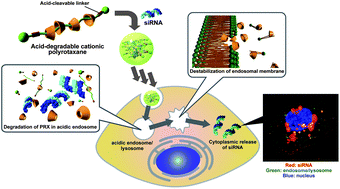A supramolecular endosomal escape approach for enhancing gene silencing of siRNA using acid-degradable cationic polyrotaxanes†
Abstract
Acid-degradable cationic polyrotaxanes (PRXs) composed of N,N-dimethylaminoethyl (DMAE) group-modified α-cyclodextrins (CDs) that were threaded onto a poly(ethylene glycol) capped with a bulky stopper via acid-cleavable 3-sulfanylpropionyl ester linkages (DMAE–COO–PRX) were developed for improving the cytoplasmic transportation of PRX/siRNA polyplexes. In response to acidic pH in endosomes, the ester linkages of the DMAE–COO–PRXs were hydrolyzed and an abundance of DMAE-modified α-CDs was released from the PRXs. Wherein, the released DMAE-modified α-CDs showed endosomal membrane destabilization through the removal of phospholipids from the membrane, resulting in the endosomal escape of siRNA. The confocal fluorescence microscopic observation revealed that the colocalization ratio of siRNAs to endosomes decreased for DMAE–COO–PRX in comparison with disulfide-introduced PRX (DMAE–SS–PRX). As a result, the DMAE–COO–PRX/siRNA showed higher gene silencing activity than DMAE–SS–PRX and linear poly(ethylenimine) (L-PEI) even at low siRNA concentration (10 nM). Therefore, the DMAE–COO–PRXs are an effective candidate as a carrier for cytoplasmic siRNA delivery.


 Please wait while we load your content...
Please wait while we load your content...